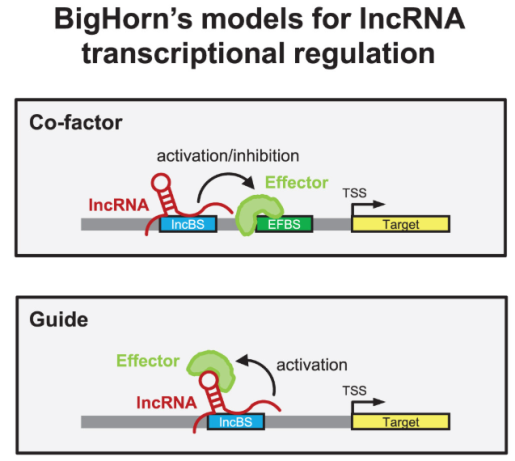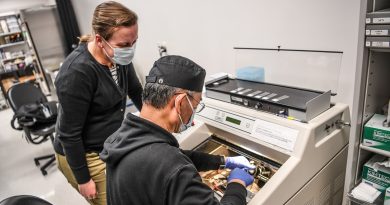Long non-coding RNAs reveal an unexpected way to regulate gene expression

Long non-coding RNAs (lncRNA) are a type of RNA molecule that do not carry instructions to make proteins. Instead, they influence how other genes are expressed. There are tens of thousands of lncRNAs in the human body, many of which are active in specific tissues or diseases like cancer. However, figuring out exactly what they do has been a major challenge.

Led by Baylor College of Medicine first authors Dr. Hua-Sheng Chiu and Sonal Somvanshi, researchers at Baylor, Ghent University in Belgium, Tsinghua University in China and other collaborating institutions worked together to better understand how lncRNAs function. Their findings revealed that lncRNAs seem to regulate gene expression in a coordinated manner that had not been seen before. Their study is the cover story of this month’s issue of Cell Genomics.
Long non-coding RNAs have been involved in many key cell processes, including cell and tissue development. They may bind DNA regions to regulate gene transcription into RNA or regulate post-transcriptional events – the processing of these RNAs by altering their stability, degradation and translation into proteins.

“Despite their abundance and their association with specific diseases, only the functions of a few lncRNAs have been fully characterized,” said lead corresponding author Dr. Pavel Sumazin, associate professor of pediatrics and member of the Jan and Dan Comprehensive Cancer Center at Baylor. He also is the director of the Bioinformatics Core Laboratory at Texas Children’s Hospital. “However, these studies have often been unable to provide mechanistic insights into lncRNA function.”
The team began by developing a powerful new computational tool called BigHorn that uses machine learning to predict where lncRNAs bind to DNA and which genes they regulate. Unlike older methods that rely on stringent sequence matching, BigHorn looks for more flexible “elastic” patterns in the DNA that better reflect how lncRNAs behave in living cells.
We tested BigHorn on data from more than 27,000 samples, including many types of cancer,” said Chiu, assistant professor of pediatrics – oncology at Baylor and Texas Children’s Hospital. “We found that it significantly outperformed previous tools in predicting lncRNA-DNA interactions.”
Interestingly, BigHorn accurately identified cases where a single lncRNA regulates a gene at both the transcriptional and post-transcriptional levels – a new phenomenon the researchers call coordinated regulation. “These lncRNAs may act as molecular chaperones that control the stability and translation of mRNAs they helped transcribe, leading to tightly coupled expression profiles,” Chiu said.
To demonstrate how powerful this approach can be, the team focused on one lncRNA called ZFAS1. This molecule often is found in high levels in cancer cells and was predicted by BigHorn to regulate many important genes.
“One of the key targets of ZFAS1 is DICER1, a cancer gene that plays a central role in producing microRNAs – tiny molecules that help fine-tune gene expression,” Sumazin said. “We found that ZFAS1 not only helps turn on the DICER1 gene but also protects its mRNA from being degraded. This dual action makes DICER1 tightly dependent on the expression of ZFAS1, which acts like a dial to regulate DICER1 levels, which in turn affect the entire network of microRNAs in the cell.”
While we focused on one interaction, our findings suggested that lncRNAs regulate genes across cancers to effectively regulate cancer programs,” Sumazin said. “In every cancer cell type, hundreds of lncRNAs appear to control hundreds of genes in this dual fashion, creating tightly linked expression patterns that are especially important in diseases like cancer.”
The BigHorn tool is publicly available (https://openrna.org/), and the authors hope it will help scientists uncover the new roles of lncRNAs in everything from development to aging to cancer.
Other contributors to this work include Chung-Te Chang, Eric James de Bony de Lavergne, Zhaowen Wei, Chih-Hung Hsieh, Wim Trypsteen, Kathleen A. Scorsone, Ektaben Patel, Tien T. Tang, David B. Flint, Mohammad Javad Najaf Panah, Hyunjae Ryan Kim, Purva Rathi, Yan-Hwa Wu Lee, Sarah E. Woodfield, Sanjeev A. Vasudevan, Andras Attila Heczey, M. Waleed Gaber, Gabriel O. Sawakuchi, Ting-Wen Chen, Pieter Mestdagh and Xuerui Yang. The researchers are affiliated with one or more of the following institutions: Baylor College of Medicine, Texas Children’s Hospital, Ghent University – Belgium, Tsinghua University – China, National Yang Ming Chiao Tung University – Taiwan and the University of Texas MD Anderson Cancer Center – Houston.
This project was supported by CPRIT awards RP180674, RP200504 and RP230120; European Union’s Horizon 2020 research and innovation program under grant agreement 826121; National Cancer Institute awards R21CA223140 and R21CA286257; a Special Research Fund postdoctoral scholarship from Ghent University (BOF21/PDO/007); and the National Natural Science Foundation of China grants W2411012 and 32330022. BCM Advanced Cores are supported by NIH grants P01CA261669, P30CA125123, S10OD018033, S10OD023469, S10OD025240 and P30EY002520.
Follow From the Labs on X, BlueSky and Instagram!



